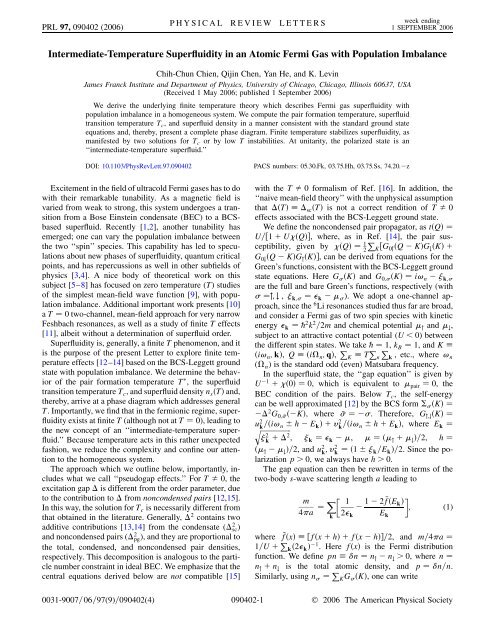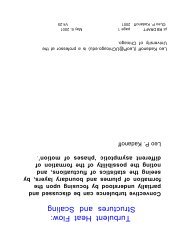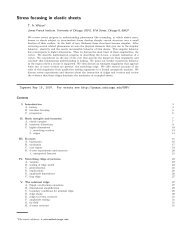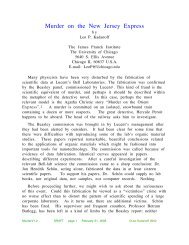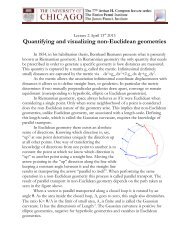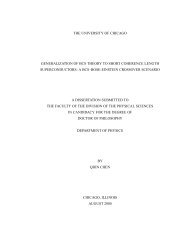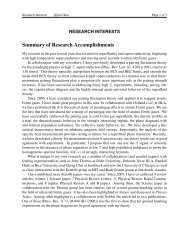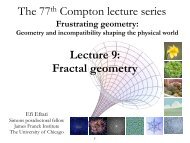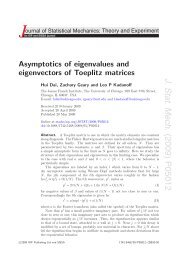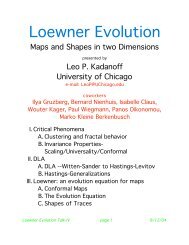Phys. Rev. Lett. 97, 090402 (2006) - APS Link Manager - American ...
Phys. Rev. Lett. 97, 090402 (2006) - APS Link Manager - American ...
Phys. Rev. Lett. 97, 090402 (2006) - APS Link Manager - American ...
You also want an ePaper? Increase the reach of your titles
YUMPU automatically turns print PDFs into web optimized ePapers that Google loves.
PRL <strong>97</strong>, <strong>090402</strong> (<strong>2006</strong>)<br />
Intermediate-Temperature Superfluidity in an Atomic Fermi Gas with Population Imbalance<br />
Chih-Chun Chien, Qijin Chen, Yan He, and K. Levin<br />
James Franck Institute and Department of <strong>Phys</strong>ics, University of Chicago, Chicago, Illinois 60637, USA<br />
(Received 1 May <strong>2006</strong>; published 1 September <strong>2006</strong>)<br />
We derive the underlying finite temperature theory which describes Fermi gas superfluidity with<br />
population imbalance in a homogeneous system. We compute the pair formation temperature, superfluid<br />
transition temperature Tc, and superfluid density in a manner consistent with the standard ground state<br />
equations and, thereby, present a complete phase diagram. Finite temperature stabilizes superfluidity, as<br />
manifested by two solutions for Tc or by low T instabilities. At unitarity, the polarized state is an<br />
‘‘intermediate-temperature superfluid.’’<br />
DOI: 10.1103/<strong>Phys</strong><strong>Rev</strong><strong>Lett</strong>.<strong>97</strong>.<strong>090402</strong> PACS numbers: 05.30.Fk, 03.75.Hh, 03.75.Ss, 74.20. z<br />
Excitement in the field of ultracold Fermi gases has to do<br />
with their remarkable tunability. As a magnetic field is<br />
varied from weak to strong, this system undergoes a transition<br />
from a Bose Einstein condensate (BEC) to a BCSbased<br />
superfluid. Recently [1,2], another tunability has<br />
emerged; one can vary the population imbalance between<br />
the two ‘‘spin’’ species. This capability has led to speculations<br />
about new phases of superfluidity, quantum critical<br />
points, and has repercussions as well in other subfields of<br />
physics [3,4]. A nice body of theoretical work on this<br />
subject [5–8] has focused on zero temperature (T) studies<br />
of the simplest mean-field wave function [9], with population<br />
imbalance. Additional important work presents [10]<br />
a T 0 two-channel, mean-field approach for very narrow<br />
Feshbach resonances, as well as a study of finite T effects<br />
[11], albeit without a determination of superfluid order.<br />
Superfluidity is, generally, a finite T phenomenon, and it<br />
is the purpose of the present <strong>Lett</strong>er to explore finite temperature<br />
effects [12–14] based on the BCS-Leggett ground<br />
state with population imbalance. We determine the behavior<br />
of the pair formation temperature T , the superfluid<br />
transition temperature T c, and superfluid density n s T and,<br />
thereby, arrive at a phase diagram which addresses general<br />
T. Importantly, we find that in the fermionic regime, superfluidity<br />
exists at finite T (although not at T 0), leading to<br />
the new concept of an ‘‘intermediate-temperature superfluid.’’<br />
Because temperature acts in this rather unexpected<br />
fashion, we reduce the complexity and confine our attention<br />
to the homogeneous system.<br />
The approach which we outline below, importantly, includes<br />
what we call ‘‘pseudogap effects.’’ For T 0, the<br />
excitation gap is different from the order parameter, due<br />
to the contribution to from noncondensed pairs [12,15].<br />
In this way, the solution for T c is necessarily different from<br />
that obtained in the literature. Generally, 2 contains two<br />
additive contributions [13,14] from the condensate ( 2 sc)<br />
and noncondensed pairs ( 2 pg), and they are proportional to<br />
the total, condensed, and noncondensed pair densities,<br />
respectively. This decomposition is analogous to the particle<br />
number constraint in ideal BEC. We emphasize that the<br />
central equations derived below are not compatible [15]<br />
PHYSICAL REVIEW LETTERS week ending<br />
1 SEPTEMBER <strong>2006</strong><br />
with the T 0 formalism of Ref. [16]. In addition, the<br />
‘‘naive mean-field theory’’ with the unphysical assumption<br />
that T sc T is not a correct rendition of T<br />
effects associated with the BCS-Leggett ground state.<br />
We define the noncondensed pair propagator, as t Q<br />
0<br />
U= 1 U Q , where, as in Ref. [14], the pair sus-<br />
ceptibility, given by Q 1<br />
P<br />
2 K G0" Q K G # K<br />
G0# Q K G " K , can be derived from equations for the<br />
Green’s functions, consistent with the BCS-Leggett ground<br />
state equations. Here G K and G0; K i! n k;<br />
are the full and bare Green’s functions, respectively (with<br />
"; # , k; k ). We adopt a one-channel approach,<br />
since the 6Li resonances studied thus far are broad,<br />
and consider a Fermi gas of two spin species with kinetic<br />
energy k @2k2 =2m and chemical potential " and #,<br />
subject to an attractive contact potential (U 0, where n<br />
n " n # is the total<br />
P<br />
atomic density, and p n=n.<br />
Similarly, using n KG K , one can write<br />
0031-9007=06=<strong>97</strong>(9)=<strong>090402</strong>(4) <strong>090402</strong>-1 © <strong>2006</strong> The <strong>American</strong> <strong>Phys</strong>ical Society
PRL <strong>97</strong>, <strong>090402</strong> (<strong>2006</strong>)<br />
n 2 X<br />
k<br />
pn X<br />
k<br />
v 2 k<br />
k<br />
f Ek ; (2a)<br />
Ek f E k h f E k h : (2b)<br />
Note that, except for the number difference [Eq. (2b)], all<br />
equations including those below can be obtained from their<br />
unpolarized counterparts by replacing f x and its derivative<br />
f 0 x with f x and f 0 x , respectively.<br />
While Eqs. (1) and (2) have been written down in the<br />
literature [5,11], the present derivation can be used to go<br />
further and to determine the dispersion relation and the<br />
number density for noncondensed pairs. We find<br />
X<br />
t Q ; (3)<br />
2<br />
pg<br />
Q 0<br />
which vanishes at T<br />
fluid phase, t<br />
2 0, where 2<br />
sc. In the super-<br />
1 Q Q 0 Z q to first<br />
order in and after<br />
P<br />
analytical continuation (i n !<br />
i0 ). Here Q kf 1 f Ek f q k = Ek q k i n u2 k f Ek f q k = Ek q k<br />
i n v2 k<br />
g. It follows that the inverse residue Z<br />
n 2 P k f k =2 2 2 . Thus, pg Z 1P qb q , where<br />
b x is the Bose distribution function. To lowest order in q,<br />
the pair dispersion q q2 =2M , where the effective pair<br />
mass M can be computed from a low q expansion of q.<br />
This q2 dispersion is associated [12] with BCS-type ground<br />
states, which have been the basis for essentially all population<br />
imbalance work.<br />
Importantly, Eqs. (1)–(3) can be used to determine Tc as<br />
the extremal temperature(s) in the normal state at which<br />
2 noncondensed pairs exhaust the total weight of so that<br />
2 2<br />
pg . Solving for the ‘‘transition temperature’’ in the<br />
absence of pseudogap effects leads to the quantity TMF c .<br />
More precisely, TMF c is defined to be the temperature at<br />
which T vanishes within Eqs. (1) and (2). This provides<br />
a reasonable estimate for the pairing onset temperature T ,<br />
when a stable superfluid phase exists. It should be noted<br />
that T represents a smooth crossover rather than an abrupt<br />
phase transition and that Eq. (1) must be altered [17] above<br />
Tc to include finite pair. We will see that understanding<br />
the behavior of TMF c is a necessary first step en route to<br />
understanding the behavior of T c itself.<br />
The superfluid density n s T is also required to vanish at<br />
the same value(s) for T c, as deduced above. Our calculation<br />
of n s closely follows previous work [14,18] for the case of<br />
the unpolarized superfluid. There is an important cancellation<br />
between the current vertex and self-energy contributions<br />
involving 2 pg so that, as expected, n s T varies with<br />
the order parameter 2 sc. It is given by<br />
n s T<br />
4<br />
3<br />
X<br />
2 k<br />
sc<br />
k E2 k<br />
1 2f E k<br />
2E k<br />
which at T 0 agrees with Ref. [5].<br />
PHYSICAL REVIEW LETTERS week ending<br />
1 SEPTEMBER <strong>2006</strong><br />
f 0 E k ; (4)<br />
<strong>090402</strong>-2<br />
The stability requirements for the superfluid phase have<br />
been discussed in the literature [5]. In general, one requires<br />
that the superfluid density be positive and that the 2 2<br />
‘‘number susceptibility’’ matrix for @n =@ 0 have only<br />
positive eigenvalues when the gap equation is satisfied. The<br />
dependence of n introduces into the matrix the overall<br />
factor @2 =@ 2 1 ;h . Thus, the second stability requirement<br />
is equivalent to the condition that<br />
@ 2<br />
@ 2<br />
;h<br />
2 X<br />
k<br />
2<br />
E 2 k<br />
1 2f E k<br />
2E k<br />
f 0 E k > 0: (5)<br />
Here is the thermodynamical potential. A third stability<br />
requirement, specific to the present calculations, is that the<br />
pair mass M > 0.<br />
In Fig. 1, we present a plot of T MF<br />
c as a function of 1=k Fa<br />
for a range of p. In the inset, we plot T at different<br />
1=kFa for p 0:3. Forp0) is provided by studying the momentum<br />
distribution n k at T 0 and finite T. AtT<br />
p<br />
0, pairing<br />
2 2<br />
is present only for k below<br />
p 1 max 0; h<br />
2 2<br />
and above 2 h . This polarized T 0<br />
state requires that pairs persist to relatively high energies<br />
MF<br />
Tc /TF<br />
0.4<br />
0.3<br />
0.2<br />
0.1<br />
1/kFa = 0.2<br />
-0.1<br />
0.6<br />
-0.3<br />
0.4<br />
-0.5<br />
-0.65<br />
0.2<br />
0 0.2<br />
T/TF 0.4<br />
0<br />
0.6<br />
p = 0.01<br />
0.02 0.05<br />
0.1<br />
0.2<br />
∆/E F<br />
0<br />
-3 -2 -1<br />
1/kFa 0 1<br />
FIG. 1 (color online). Mean-field behavior of TMF c as a function<br />
of 1=kFa for different p. Shown in the inset is the pairing<br />
gap T at different 1=kFa for p 0:3. Here EF kBTF @2k2 F =2m is the noninteracting Fermi energy for p 0.<br />
0.3<br />
0.5<br />
0.7<br />
0.9<br />
0.99
PRL <strong>97</strong>, <strong>090402</strong> (<strong>2006</strong>)<br />
k > 2, as a result of the Pauli principle which pushes<br />
these states out of the ‘‘normal’’ regime occupied by the<br />
majority species. This kinetic energy cost competes with<br />
the gain from condensation energy, and, for a sufficiently<br />
weak attraction, this ‘‘breached pair’’ structure [20] becomes<br />
unstable at T 0. By contrast, at finite T the regime<br />
originally occupied exclusively by the majority species<br />
between 1 and 2 is no longer completely filled, and pairs<br />
can ‘‘spill over’’ from both lower and higher energy states<br />
into this regime. This not only helps lower the kinetic<br />
energy but allows the normal regime to participate in<br />
pairing and, thus, lowers the potential energy. In this<br />
way, temperature can enhance pairing. It should be noted<br />
that the majority species between 1 and 2 contains a<br />
pairing self-energy and is different from a free Fermi gas.<br />
Figure 2 represents solutions for Tc of our central equation<br />
set [Eqs. (1)–(3)] as a function of 1=kFa for the entire<br />
range of p. If the solution for Tc falls into the shaded<br />
region, there is no stable superfluid [since @2 =@ 2 < 0,<br />
through Eq. (5)]. For low polarizations p & 0:185, the<br />
behavior of Tc is similar to that of TMF c when one approaches<br />
the BCS regime. There may be one or two Tc’s which, when stable, will be associated with intermediatetemperature<br />
superfluidity. When p>0:185, however, no<br />
solution can be found for the regime 1=kFa & 0:18, because<br />
M < 0 there. We stress that the origin of the<br />
intermediate-temperature superfluid we find here lies in a<br />
very early stage of the calculations; it can already be seen<br />
as a consequence of the constraints imposed on the pairing<br />
gap in the low T regime when there is a delicate energetic<br />
balance between normal and paired states [see Eqs. (1) and<br />
(2) and Fig. 1].<br />
In Fig. 3, we summarize our observations in the form of<br />
a general temperature phase diagram. In region I, the<br />
system is normal and superfluidity is absent. However,<br />
this normal phase need not be a Fermi gas. Close to the<br />
boundary, as shown in the inset in Fig. 1 (bottom curve),<br />
finite T pairing may occur with or without phase coherence.<br />
In region III, stable superfluidity is present for all<br />
T c /T F<br />
0.3<br />
0.2<br />
0.1<br />
∂ 2 Ω/∂∆ 2 =0<br />
0.01 = p<br />
0.05<br />
0.1<br />
0.13<br />
0.14<br />
0.16<br />
0.18<br />
0.2<br />
0.3<br />
0.5<br />
0.7<br />
0.9<br />
0.99<br />
0.1<br />
0.05<br />
0.13<br />
0.2<br />
0.3<br />
0.01<br />
0.99<br />
0<br />
-3 -2 -1 0<br />
1/kFa 1 2 3<br />
0.01<br />
0.18<br />
0.16<br />
FIG. 2 (color online). T c as a function of 1=k Fa for different p.<br />
The T c curve splits into two disconnected curves for 0:14 & p &<br />
0:185. The T c solution inside the shaded area is unstable.<br />
0.14<br />
PHYSICAL REVIEW LETTERS week ending<br />
1 SEPTEMBER <strong>2006</strong><br />
0.5<br />
0.7<br />
0.9<br />
<strong>090402</strong>-3<br />
T Tc. Finally, in region II, within the shaded region (IIC<br />
and IID), we find a stable polarized superfluid phase for<br />
intermediate temperatures, not including T 0, which we<br />
refer to as intermediate-temperature superfluidity. In IIA<br />
and IIB, no stable polarized superfluid is found. The nearly<br />
vertical line represents Tc 0 around 1=kFa 0:18,<br />
roughly independent of p (see Fig. 2).<br />
Finite momentum condensates [10,21] may well occur<br />
in any of the regimes in II, particularly IIA and IIB, for<br />
which our equations do not yield stable zero momentum<br />
condensation. Future work will explore the nature of the<br />
stable phases in these regimes. The boundaries of the<br />
region denoted II can be compared with other T 0 phase<br />
diagrams in the literature [5,10]. In contrast to Ref. [5], we<br />
find that the most stringent criterion for stability at T 0 is<br />
the positivity of the second order partial derivative<br />
@2 =@ 2 [as given in Eq. (5)]. This defines the boundary<br />
between II and III. This is substantially different from the<br />
line associated with ns 0 0 (used in Ref. [5]) which is<br />
described by a nearly vertical line from p; 1=kFa 1; 0:3 to 0; 0:6 . Similarly, the locus of points in the<br />
two-dimensional parameter space p; 1=kFa where TMF c<br />
vanishes defines the boundary between I and II, as is<br />
consistent with its counterpart in Ref. [5].<br />
In region IID, we define Tunstable (which is below the<br />
single Tc) as the temperature where the system becomes<br />
unstable, via Eq. (5). At a given 1=kFa, Tunstable decreases<br />
with decreasing p and approaches 0 as p ! 0. This is<br />
p<br />
1<br />
0.8<br />
0.6<br />
0.4<br />
0.2<br />
SF<br />
Unstable<br />
0 p<br />
0<br />
0.3<br />
MF<br />
Tc = 0<br />
Tc = 0<br />
∂ 2 Ω/∂∆ 2 = 0<br />
Finite T SF<br />
I<br />
T c<br />
0.3<br />
T/T F<br />
IIA<br />
IIC IID<br />
IIB<br />
0<br />
-3 -2 -1 0<br />
1/kFa 1 2 3<br />
FIG. 3 (color online). Phase diagram on the p 1=kFa plane<br />
with the nearly vertical line corresponding to Tc 0. Yellow<br />
region (shaded) corresponds to intermediate-temperature superfluidity.<br />
Region I, the system is normal; IIA, M < 0 so no<br />
solution for Tc exists; IIB, solution for Tc exists but superfluid<br />
state is unstable; IIC, superfluid state exists at intermediate T<br />
between upper and lower Tc’s but not T 0; IID, superfluid<br />
state exists at finite T but becomes unstable at a low temperature<br />
Tunstable (shown in the inset for 1=kFa 0:5) where ns is finite;<br />
III, superfluid state exists for all T Tc > 0. The chemical<br />
potential changes sign within regions IIB and IID (close to<br />
1=kFa 0:6 for all p), while ns 0 vanishes along a nearly<br />
vertical line (not shown) between p; 1=kFa 1; 0:3 and<br />
0; 0:6 . The p 0 boundary is not continuously connected to<br />
the rest of the phase diagram.<br />
III
PRL <strong>97</strong>, <strong>090402</strong> (<strong>2006</strong>)<br />
n s /n<br />
1<br />
0.8<br />
0.6<br />
0.4<br />
1/k F a=1.5<br />
1.0<br />
0.2<br />
0.5<br />
n s0 /n<br />
0<br />
0 0.4<br />
1-p<br />
0.8<br />
0.2<br />
-0.5<br />
0<br />
0<br />
0 0.1 0.2<br />
T/TF shown in the inset in Fig. 3 for 1=k Fa 0:5. In region IIC,<br />
the lower T c approaches 0 as p approaches 0. Thus, there is<br />
an important distinction between the p 0 and p ! 0<br />
limits, especially at T 0. Forp small but finite, calculations<br />
readily encounter instabilities at strictly T 0, and<br />
here superfluidity is very fragile to the introduction of<br />
small imbalance. By contrast, at finite T this fragility is<br />
not as pronounced. We conclude that only T 0 is a problematic<br />
temperature for weakly polarized superfluidity.<br />
Figure 4 presents n s T for p 0:1. Except for the case<br />
1=k Fa 1:5, Fig. 4 shows the typical behavior in region II<br />
(of Fig. 3) corresponding to intermediate-temperature<br />
superfluidity. The observations here (and associated nonmonotonicities)<br />
for n s T are similar in many ways to what<br />
is seen for T in the inset in Fig. 1. In region IIC, n s goes<br />
to zero at the upper and lower T c, whereas in IID, n s T<br />
abruptly stops at T unstable. The dotted lines indicate that<br />
they are in the unstable regime. Throughout region III, n s is<br />
found to be monotonically decreasing with increasing T,as<br />
in conventional superfluids. Finally, in the inset in Fig. 4,<br />
we plot n s0 n s 0 as a function of 1 p 2n #=n. Only<br />
in the deep BEC regime is the dependence linear. This plot<br />
reflects that the excess unpaired fermions interact with the<br />
paired states, leading to a reduced superfluid density at<br />
T 0 relative to 2n #.<br />
The experimental situation regarding the stability of a<br />
unitary polarized superfluid (UPS) is currently being unraveled<br />
[1,2]. If one includes the trap, within the local<br />
density approximation it appears [6,7,11] that the local<br />
polarization p r , in effect, increases continuously from a<br />
small value at the trap center to 100% at the trap edge. It<br />
follows from this <strong>Lett</strong>er that at very low T the superfluid<br />
trap center will not support polarization, but, for a range of<br />
T closer to T c, polarization can penetrate the core. We<br />
estimate from Fig. 2 (assuming the central p 0:05) that<br />
0.8<br />
0.4<br />
0.6<br />
0.7<br />
1<br />
1.5<br />
2<br />
3<br />
1/k F a<br />
FIG. 4 (color online). Normalized superfluid density n s=n as a<br />
function of T=T F at p 0:1 for various 1=k Fa from BCS to<br />
BEC, corresponding to regions IIC (1=k Fa 0:5 and 0), IID<br />
(0.2, 0.5, 1.0), and III (1.5), respectively. The inset plots n s0<br />
n s T 0 versus 1 p for different 1=k Fa, indicating n s0 !<br />
2n # in the BEC limit. The dotted (segments of the) curves<br />
represent unstable solutions within region IIB (IID).<br />
PHYSICAL REVIEW LETTERS week ending<br />
1 SEPTEMBER <strong>2006</strong><br />
3<br />
0.6<br />
<strong>090402</strong>-4<br />
there exists a UPS for T 0:05–0:25T F. Given the temperature<br />
range in experiment [1], this appears to be not<br />
inconsistent with current data [T F 1:9 K, T<br />
300–505 nK 0:16–0:27 T F on resonance]. In the near-<br />
BEC regime, our predictions also appear consistent with<br />
new data in Ref. [22]. More generally, because the local<br />
p r 0 is small and the unstable region is suppressed to<br />
very low T as p ! 0, this may explain why superfluidity in<br />
atomic traps can be observed experimentally. Future theory<br />
including the trap will be required to provide quantitative<br />
comparison with experiment.<br />
This work was supported by NSF-MRSEC Grant<br />
No. DMR-0213745, and we thank C. Chin, W. Yi, M. W.<br />
Zwierlein, and R. G. Hulet for useful communications.<br />
[1] M. W. Zwierlein, A. Schirotzek, C. H. Schunck, and<br />
W. Ketterle, Science 311, 492 (<strong>2006</strong>).<br />
[2] G. B. Partridge, W. Li, R. I. Kamar, Y. A. Liao, and R. G.<br />
Hulet, Science 311, 503 (<strong>2006</strong>).<br />
[3] W. V. Liu and F. Wilczek, <strong>Phys</strong>. <strong>Rev</strong>. <strong>Lett</strong>. 90, 047002<br />
(2003).<br />
[4] M. M. Forbes, E. Gubankova, W. V. Liu, and F. Wilczek,<br />
<strong>Phys</strong>. <strong>Rev</strong>. <strong>Lett</strong>. 94, 017001 (2005).<br />
[5] C. H. Pao, S. T. Wu, and S. K. Yip, <strong>Phys</strong>. <strong>Rev</strong>. B 73,<br />
132506 (<strong>2006</strong>).<br />
[6] T. N. De Silva and E. J. Mueller, <strong>Phys</strong>. <strong>Rev</strong>. A 73,<br />
051602(R) (<strong>2006</strong>).<br />
[7] M. Haque and H. T. C. Stoof, cond-mat/0601321.<br />
[8] P. Pieri and G. C. Strinati, <strong>Phys</strong>. <strong>Rev</strong>. <strong>Lett</strong>. 96, 150404<br />
(<strong>2006</strong>).<br />
[9] A. J. Leggett, in Modern Trends in the Theory of<br />
Condensed Matter (Springer-Verlag, Berlin, 1980),<br />
pp. 13–27.<br />
[10] D. Sheehy and L. Radzihovsky, <strong>Phys</strong>. <strong>Rev</strong>. <strong>Lett</strong>. 96,<br />
060401 (<strong>2006</strong>).<br />
[11] W. Yi and L. M. Duan, <strong>Phys</strong>. <strong>Rev</strong>. A 73, 031604(R)<br />
(<strong>2006</strong>).<br />
[12] Q. J. Chen, J. Stajic, S. N. Tan, and K. Levin, <strong>Phys</strong>. Rep.<br />
412, 1 (2005).<br />
[13] I. Kosztin, Q. J. Chen, B. Jankó, and K. Levin, <strong>Phys</strong>.<br />
<strong>Rev</strong>. B 58, R5936 (1998).<br />
[14] Q. J. Chen, I. Kosztin, B. Jankó, and K. Levin, <strong>Phys</strong>. <strong>Rev</strong>.<br />
<strong>Lett</strong>. 81, 4708 (1998).<br />
[15] P. Pieri and G. C. Strinati, <strong>Phys</strong>. <strong>Rev</strong>. B 71, 094520 (2005).<br />
[16] P. Nozières and S. Schmitt-Rink, J. Low Temp. <strong>Phys</strong>. 59,<br />
195 (1985).<br />
[17] Q. J. Chen, J. Stajic, and K. Levin, <strong>Phys</strong>. <strong>Rev</strong>. <strong>Lett</strong>. 95,<br />
260405 (2005).<br />
[18] J. Stajic, A. Iyengar, Q. J. Chen, and K. Levin, <strong>Phys</strong>. <strong>Rev</strong>.<br />
B 68, 174517 (2003).<br />
[19] A. Sedrakian and U. Lombardo, <strong>Phys</strong>. <strong>Rev</strong>. <strong>Lett</strong>. 84, 602<br />
(2000).<br />
[20] G. Sarma, J. <strong>Phys</strong>. Chem. Solids 24, 1029 (1963).<br />
[21] T. Mizushima, K. Machida, and M. Ichioka, <strong>Phys</strong>. <strong>Rev</strong>.<br />
<strong>Lett</strong>. 94, 060404 (2005).<br />
[22] M. W. Zwierlein, C. H. Schunck, A. Schirotzek, and<br />
W. Ketterle, Nature (London) 442, 54 (<strong>2006</strong>).


